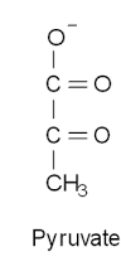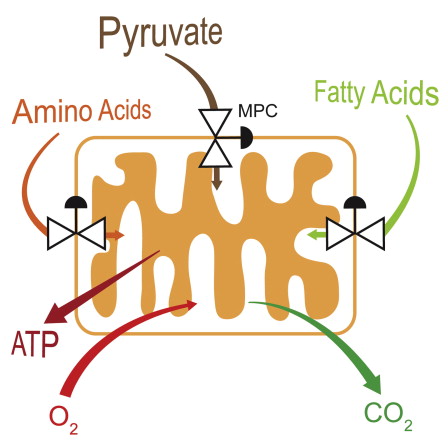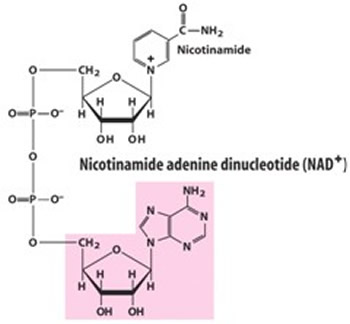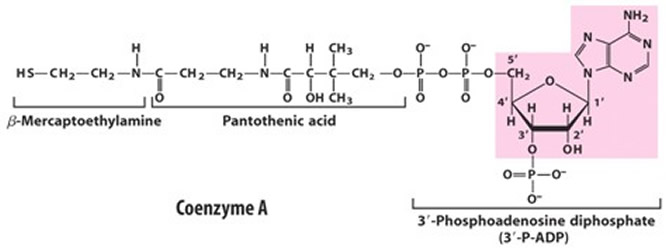Biological Processes and Interactions
Cellular Respiration: Tapping into the Energy in Food
MINDS ON
Some Key Terms
Look for these terms in this Activity. You should practice using them as you compose your responses to the upcoming tasks.
Realize, though, that this list is not exhaustive so you should look for opportunities to include other relevant terminology related to aerobic and anaerobic respiration.
| Substrate-level phosphorylation | oxidative phosphorylation | electron transport chain |
| proton gradient | glycolysis | lactate fermentation |
| alcoholic fermentation | pyruvate oxidation | citric acid cycle |
| crista (plural is cristae) | matrix | ATP synthase |
| potential energy | deamination | beta-oxidation |
| feedback inhibition |
Biochemical Reactions
Cellular respiration is used by all organisms. Autotrophs store carbohydrates and lipids using G3P from the light-independent reactions. Later, perhaps in response to an improvement in growing conditions, they tap into those stored energy sources. Heterotrophs similarly convert macronutrients they consume or have stored into ATP.
Just like in the light-dependent reactions, many organisms create a proton gradient that ATP synthase can use to phosphorylate ADP. Watch this process in the following animation from St. Olaf College.
ATPSynthase
Look back at your graphic organizer from Unit 1, Activity 5 on nucleic acids, we learned about coenzymes like NAD+, FAD, and Coenzyme A.
Many biochemical reactions are used by cells in the steps of cellular respiration. Dozens of enzymes catalyze these reactions. For example, a cysteine amino acid in the active site of the enzyme glyceraldehyde-3-dehydrogenase is involved in both a reduction and phosphorylation reaction. Watch this animation from St. Olaf College.
ChemicalInteraction
Interestingly, the substrate for glyceraldehyde-3-dehydrogenase is a molecule produced in photosynthesis. Likewise, using a proton gradient to produce ATP happens in both photosynthesis and cellular respiration. Even the overall chemical equation for aerobic cellular respiration reminds us of photosynthesis:
C6H12O6 + 6 O2 → 6 H2O + 6 CO2
 How do small steps lead to changes?
How do small steps lead to changes?
Changes 8. Think of your work from Unit 2, Activity 4 on Photosynthesis or your past learning about plants and photosynthesis. Using these details as well as those you have just read, compare cellular respiration with photosynthesis. Your comparison should include at least 3 similarities and/or differences.
Energy for Movement
The primary purpose of cellular respiration is to produce ATP as needed for cells. If we think of food as fuel then how energy is stored and released from fuel is similar in many ways to energy transfer in food. When burning wood, heat is used to start the fire and it is also produced. In this video from the Genetic Science Learning Centre, we can see how ATP is also used to start cellular respiration and it is a product.
For example, a lynx burns a lot of energy when it is chasing prey. Its muscle cells demand ATP so mitochondria convert potential energy into kinetic energy. Predators like the lynx only run for short periods of time before they slow down and their energy stores are depleted: either they have caught their prey, or the prey escaped.

Similarly, we become aware of the limitation to using our muscles as they tire during strenuous or repetitive work. Perhaps our muscles shake as we try to do one more push-up. Or maybe we find we just can’t run any further so we stop to catch our breath. These are changes that we seem to do involuntarily. Our muscle cells continue to produce ATP to move, only we change the way it is made. Try this simple investigation to explore this further.
Investigation: Muscle Fatigue
Materials Needed:
- a clothespin (or binder clip)
- a timer
Procedure:
- Hold a clothes pin in the thumb and index finger of your dominant hand. Open it all the way and close it as fast as possible in 30 seconds while the other fingers of the hand are held in a neutral position. Attempt to squeeze quickly and completely, to get the maximum number of squeezes for each trial.
- If possible, have a partner record the number so you can continue without resting.
- Repeat this process for nine more 30 second trials recording the result for each trial. Do not rest your fingers between trials.
- Repeat steps 1 and 2 for the non-dominant hand. Record all data in a table. You may find it useful to also graph the results for both hands on one graph in order to better interpret your results.
If you prefer you can download a copy of this investigation.
 How do small steps lead to changes?
How do small steps lead to changes?
Use quantitative and qualitative results to answer one of the following questions.
- What happened to your energy & ability to pinch the clothespin as you progressed through each trial? Explain why.
- What might cause one to be able to get more squeezes, in other words, to have less fatigue? Explain in terms of biological concepts.
- Suggest how the amount of ATP produced makes your muscle cells less efficient. When did this change in the amount of ATP produced occur in this investigation? How could you tell?
- Your muscles would probably recover enough after 10 minutes to operate at the original efficiency. Explain why.
Support your answer with your data by sharing your graph or table using a picture, video or descriptions. Explain how the results provide details to answer your question.
ACTION
Steps in a Process
Early experiments of cellular respiration focused on the consumption of oxygen gas and the production of carbon dioxide. Many biologists believed respiration to be a variation of combustion. Heat is evidence of energy production in cells. In one experiment, the amount of oxygen used and carbon dioxide made by guinea pigs was found to be equal to the gases used and made from the burning of carbon. Yet other experiments showed that the amount of oxygen used by living organisms to burn different types of food did not follow any logical patterns. Indeed, experiments with yeast showed that they could produce carbon dioxide even in the absence of oxygen. The process of producing energy in yeast and other microbes is called fermentation. Fermenting microorganisms have the ability to change food and drinks and so are used to make a range of foods including pickles, yogurt, alcohol, bread and cheese.
The rate of fermentation is shown in the following five experiments. Interpret and analyse the following graphs to make appropriate conclusions.
Fermentation
As we saw for photosynthesis, cellular respiration must include different reactions: some that involve oxygen, and some that do not. Enzymes play an important role.
Later research has identified that cellular respiration of glucose involves reactions that occur in the cytoplasm and some that occur in mitochondria in eukaryotic cells. This first process is called glycolysis. It occurs in the cytoplasm and produces a molecule called pyruvate.

2 ATP molecules are produced per glucose molecule by substrate-level phosphorylation. (definition: The reaction that makes ATP by moving a phosphate group from another compound to ADP.) From there, pyruvate can undergo different reactions depending on which species it’s in and also the amount of oxygen available to the cell. Glycolysis itself is composed of 10 individual reactions which you can see here:
For this course there is no expectation for you to remember the sequence of reactions in glycolysis. For this reason, we can think of glycolysis as happening in 3 parts:

by Edgar Gibson
Some steps in cellular respiration are aerobic, while others are anaerobic. For most eukaryotes, oxygen is one of the requirements of life. Much more ATP is produced using aerobic processes helping to provide energy for more complex forms of life. Glycolysis doesn’t require oxygen but is the first step in glucose metabolism for both aerobic and anaerobic respiration. The fermentation done by microorganisms involves anaerobic respiration.
Smaller eukaryotic and prokaryotic organisms can survive longer in low oxygen conditions, and many have adapted to produce energy without any oxygen. Under these anaerobic conditions all the energy produced from glucose is only made in glycolysis. The 2 NADH molecules are recycled back to NAD+. In this way the NAD+ can be used again for a new round of glycolysis with a new molecule of glucose.
Cells have evolved two different methods of recycling NADH. In general, most eukaryotes and certain bacteria perform lactate fermentation whereas certain fungi, like yeast, and other bacteria perform alcoholic fermentation. These two processes are summarized in the animation below by Thomas E. Schultz of the College of Science and Engineering at Central Michigan University.
 How do small steps lead to changes?
How do small steps lead to changes?
Changes 9. Compare lactate fermentation with alcoholic fermentation. Your comparison should include at least 3 similarities and/or differences.
 Mapping out Cellular Respiration
Mapping out Cellular Respiration
At the end of this Activity you will be mapping out the steps of cellular respiration in a flowchart. The flowchart should include details about both aerobic (oxygen present) and anaerobic (without oxygen) respiration. Watch one of the two following videos to learn more about the reactions. This will give you an overview of the steps in aerobic cellular respiration. Your flowchart should include these details and concepts:
- location in the cell or organelle where these reactions occur,
- the type of biochemical reactions or cellular transport,
- the substrates and products for the overall process.
Be sure to leave room for more details to add as you work through this activity.
Mitochondrial Reactions
Mitochondria, like chloroplasts, have an interesting structure.

In addition to an outer phospholipid bilayer, they also have an inner bilayer membrane that is folded into cristae. The interior of the mitochondrion is a fluid-like gel called the matrix. It’s similar to the cytoplasm of a cell or stroma of a chloroplast, and contains enzymes, substrates and mitochondrial DNA. Aerobic respiration occurs in the mitochondria. Again, as in the chloroplast performing photosynthesis, the folded membrane increases the surface area and therefore helps to increase the rate of cellular respiration.
Aerobically, pyruvate can undergo further reactions. These reactions produce significantly more ATP for cells than anaerobic processes. After glycolysis there are 2 further steps in aerobic respiration: the citric acid cycle and the electron transport chain. As both these steps occur in mitochondria, pyruvate must first be transported across the mitochondrial membrane. Some biochemists view this as a separate step, between glycolysis and the citric acid cycle, called pyruvate oxidation. For our purposes in this course we don’t need to worry about this distinction.
The first reactions in the citric acid cycle include the movement of pyruvate into the mitochondrion.
In the process, pyruvate with its 3 carbons becomes a 2-carbon functional group, acetyl. Coenzyme A helps to deliver acetyl to the next enzyme in the citric acid cycle. The sulfhydryl group in coenzyme A binds to the acetyl group. For this reason we often see the chemical formula of acetyl-CoA showing this sulfide bond.
 How do small steps lead to changes?
How do small steps lead to changes?
Changes 10. Describe the three biochemical changes as pyruvate is transported into the mitochondrion.
At this time, it’s worth noting that fatty acids and, under some circumstances, amino acids can also be used as sources of energy. Amino acids undergo deamination reactions in the liver. Those products are then converted into substrates for the citric acid cycle, including acetyl-CoA.

by NM Vacanti, AS Divakaruni, CR Green, SJ Parker, RR Henry, TP Ciaraldi, et al. Molec Cell 6 Nov 2014; 56(3):425–435
Fatty acids are also taken into mitochondria and converted to acetyl-CoA. From an aerobic energy perspective, all roads lead to the citric acid cycle.
 Mapping out Cellular Respiration
Mapping out Cellular Respiration
As you explore this video describing the reactions in the citric acid cycle look for details to add to your map of the steps in cellular respiration.
At this point, most of the chemical potential energy from glucose and other biological molecules has been converted to the two electron carriers: NADH and FADH2. These two molecules next move to the electron transport chain. (definition: a group of compounds in a membrane that pass an electron through a series of redox reactions coupled to moving H+ ions to produce a concentration gradient.) As the name suggests, electrons are moved, first from NADH and FADH2 to integral membrane proteins. The terminal electron acceptor is oxygen. Finally, in the last step of aerobic respiration oxygen is used. The oxygen that we know is so essential to life plays the important role of accepting the electrons to combine with H+ ions making water.
 Mapping out Cellular Respiration
Mapping out Cellular Respiration
As you explore this next interactive, look for details to add to your map of the steps in cellular respiration.
3Tabs
The amount of ATP produced for each glucose molecule is actually a bit less than the theoretical amounts shown here. Membranes are a bit leaky, allowing protons to pass back from the intermembrane space back into the matrix. The energy lost here is given off as heat, which is an important method of producing body heat. An easy number to remember is 30 ATP produced per glucose molecule: 2 ATP from glycolysis, 2 ATP from the citric acid cycle, and about 26 ATP from oxidative phosphorylation.
 Cellular Respiration
Cellular Respiration
What did you learn about the the reactions in cellular respiration? Complete the following.
- Three things I learned about the reactions in cellular respiration;
- Two other things I found interesting about the reactions in cellular respiration;
- One question I still have.
Changes to the reactions in cellular respiration sometimes have severe consequences. Mutations in the enzymes involved in aerobic and anaerobic pathways often cause serious, life-threatening diseases. Inhibitors of some of those enzymes can have toxic effects on the body.
 How do small steps lead to changes?
How do small steps lead to changes?
Search for a metabolic disorder or metabolic poison that affects cellular respiration. Describe what step in cellular respiration is affected. How are the consequences of this disorder or poison explained by changes in the steps of cellular respiration?
Rate of Cellular Respiration
The reactions in cellular respiration are performed by a series of enzymes in a pathway. Enzymes in this type of pathway are often controlled using a process called feedback inhibition. As you watch this animation you will see how this form of inhibition expands our understanding of enzyme inhibition.
In general, products from some of the steps of aerobic respiration inhibit cellular respiration. High levels of ATP, NADH, acetyl-CoA and citrate all inhibit enzymes earlier in the pathway.
As ATP is consumed through other cellular processes inhibition stops and cellular respiration proceeds. Furthermore, certain molecules stimulate aerobic respiration, including high levels of O2, ADP and AMP (adenosine monophosphate).
 How does energy move in food systems?
How does energy move in food systems?
In general, photosynthesis is controlled externally by environmental conditions, like light levels, temperature, or CO2 concentrations. Cellular respiration, on the other hand, is controlled largely internally through feedback inhibition.
Energy 5. Suggest a reason for why these two metabolic processes are controlled differently. Specifically, why is the way the products of cellular respiration and photosynthesis are used by cells important in how these processes are controlled?
Thinking back to the muscle fatigue investigation at the beginning of this Activity, the rate of cellular respiration changes as we consume oxygen and ATP. We now have significantly more details we can use to interpret our observations. A good summary of these details is in your flowchart, but you can also see how the steps in cellular respiration relate to exercise.
 How do small changes lead to changes?
How do small changes lead to changes?
Reflect back on the Muscle Fatigue investigation we did earlier in this Activity.
- What happened to your energy & ability to pinch the clothespin as you progressed through each trial? Why?
- What might cause one to be able to get more squeezes, in other words, to have less fatigue? Explain in terms of biological concepts.
- Suggest how the amount of ATP produced cause your muscle cells to be less efficient. When did this change in the amount of ATP produced occur in this investigation? How could you tell?
- Your muscles would probably recover enough after 10 minutes to operate at the original efficiency. Explain why.
Show how specific details from the steps of cellular respiration add details to answer this question.
 Quiz
Quiz
Check your understanding of cellular respiration by completing the following quiz.
U2A5Quiz
CONSOLIDATION
Summary
- the cells can convert the energy stored in the bonds of carbon biological molecules into ATP with or without oxygen;
- in anaerobic respiration, byproducts of ATP production are recycled;
- in aerobic respiration, energy in biological molecules is converted to potential energy in the proton gradient and then potential energy in ATP.
 Mapping Out Steps in a Process
Mapping Out Steps in a Process
In this Activity you have found details to describe the steps in aerobic and anaerobic respiration.
Check over your map of the steps in aerobic and anaerobic respiration.
Your flowchart should include these concepts and details:
- location in the cell or organelle where the reactions occur,
- the type of biochemical reactions or cellular transport,
- the substrates and products for the overall process.
Ask yourself these big questions as a way to monitor and improve your work:
- Is the information I have presented a complete representation of my learning?
- Is the information I have presented correct?
- Have I fulfilled the requirements of the task?
- Are the steps I describe organized in the correct order?


